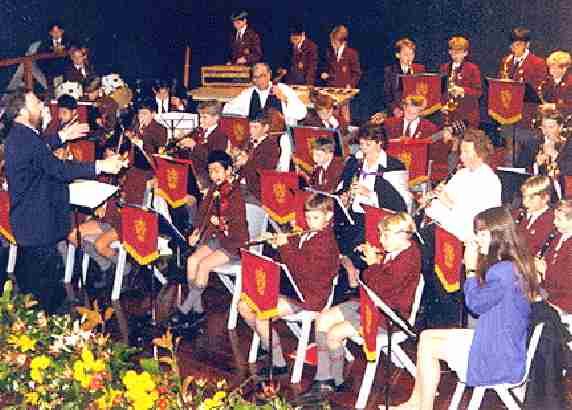
Figure 1.--This large New Zealand preparatory school has a full orchestra. The boys wear their school uniforms of maroon blazers and grey short pants.


Figure 1.--This large New Zealand preparatory school has a full orchestra. The boys wear their school uniforms of maroon blazers and grey short pants. |
Youth orchestras often do not require costumes, although dress is usually standardized. The most common type of youth orchestra are school based ones, but other groups also sponsor orcchestras. As a result school uniforms are a common costume for the orchestras. Many schools have the children wear their school uniforms for orchestral presentations. Schools without uniforms will often adopt simple orchestra outfits like white shirts and dark pants. Unlike choral groups, the orchestras have generally been mixed groups including both boys and girls, except of course single gender schools. Some schools are not large enough to have large orchestras, but many larger schools, especially secondary schools have them.
the term bands and instruments are often used interchangably, but there are important differences. An orchestra is of course a type of a band. An orchestra basically varies from a band primarily on the basis of the rane of the instruments. Orchestras are generally larger than bands, but there are some very large bands. Orchestras always have a wide range of instruments, especially a good assortment of percussion, string, and wind instruments. Bands generaly have a more narrow selection of instruments. Even a large marching ban is likely to have few string instruments and be composed largely of wind instruments, especially the brass instruments.
Youth orchestras often do not require costumes, although dress is usually standardized. This is especially the case for schools which do not have uniforms. Schools without uniforms will often adopt simple orchestra outfits like white shirts and dark pants.Schools with uniforms have the children wear their school uniforms for orchestral presentations.
The most common type of youth orchestra are school based ones, but other groups also sponsor orchestras. As a result school uniforms are a common costume for the orchestras.
There are many different types of school orcestras.
Unlike choral groups, the orchestras have generally been mixed groups including both boys and girls, except of course single gender schools. There are several factors here. Many believe that there are differences in the haracteristics of boys' and girls' voices--although there is some difference of opinion here. The prevalence of mixed-gender orchestras. This is in part a reflection of the fact that many orchestras are from schools. Modern schools are increasingly coeducational and as a result school orchestras are commonly coeducational. There are still some single gender schools and of course single gender schools were much more common in the first half of the 20th century.
School orchestras of course varied from school to school. Some had only small string, brass, wind, percussion, and other sections. Others had quite impressive sections. Of course there are differences in the proficiency of these orchestras depending on the age of the children. We have noted some children even in primariy school that achieve comsiderable proficienvy in all of these sections. Of course secondary school students are able to schieve quite notable standards.
Schools varied as to whether they sponsored orchestras. Some schools focus on the academic program. Others give considerable attention to extracurricular activities. This approach to education varies from country to country as well as over time. Some schools are not large enough to have large orchestras, but many larger schools, especially secondary schools have them. Many of the boys and youth orchestras that we have noted are school orchestras. There are other types of orchestras, but quite a number are school orchestras. Another factor here is that primary schools are generally smaller than secondary scgiils, thus affecting the size of the orchestra that can be supported. Sime schools such as full term colleges (in the sence of combined primary and secondary school) often have orcestras. Private scgools in general frequently support orchestras becuse they are well funded and almost all of the parents can afford music tuition. We have also noted sizeavle oechestras at many state secondary schools.
Virtually every major country have youth orchestras. A full orchestra is, however, an expensive undertaking. Thus orchestras are most common in wealthier ountries. They are most common in the countries of western Europe and North America and a few other countries like Australia and New Zealand. I am not sure about Japan. As the main sponsoring organization are schools, the orcestra costumes usually are a reflection of school wear. Thus the school orchestras from different countries are usually the school uniform from thee various countries. Mozst of the countries with boyorchestras ar European and North American countries, and a few other former European colonie like Australia and New Zealand. This is largely a uestion of economics. It is the higher incomelevels that permit parents to afford mudical instruments and tuition for their children. Cultural factors are also obviously important because it is Wetern music that isplayed by tese orchestras.
HBC has information at this time on only a few orchestras.
The Scottish Fiddle Orcheresta is occasionally seen on PBS. All male members of the orchestra wear kilts, including the teenage members.
Related Chronolgy Pages in the Boys' Historical Web Site
[Main Chronology Page]
[The 1880s]
[The 1930s]
[The 1940s]
[The 1950s]
[The 1960s]
[The 1970s]
[The 1980s]
Navigate the Historic Boys' Clothing Web style pages:
[Kilts]
[Caps]
[Sailor suits]
[Sailor hats]
[School uniform]
[Youth group uniforms]
